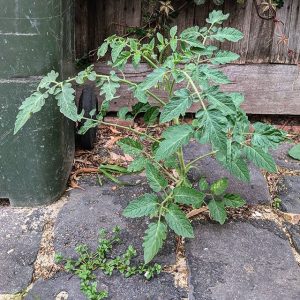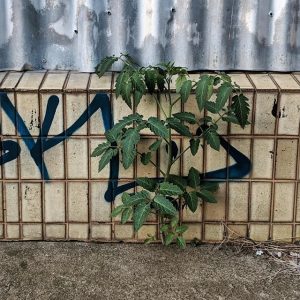Tomato (Solanum lycopersicum), a plant that appears poorly adapted for a pavement existence but tries it all the same.
Tomato has been reported as an increasingly important weed in Australia’s northern coastal areas, and something of a sleeper weed here in Victoria and in SA. According to Queensland Biosecurity, this beloved savoury fruit has become a common occurence in natural riparian areas and at revegetation sites in the north, with its ultimate potential to have negative environmental impacts unknown and presumably underestimated. The plant has been found naturalised in New Zealand since the 1860s, and has also established successful wild populations on numerous other Pacific islands.
Successful multi-generational escapes and naturalised populations are typically of the ‘cherry’ varieties, which are faster to develop to viability, scale better to limited wild resources and are less vulnerable to the punishing environment of both streets and wild places than your typical mortgage lifter or brandywine.
The plants seen here were found in Fitzroy North(frames 2 and 4), Richmond (3), Melbourne (5), Fitzroy (6), and Thornbury (1, 7-10), that last the only plant that I witnessed produce fruit. The majority died by trampling, physical removal or dehydration over the course of the summer, including that fruiting plant that was still striving to the end.
View Original Post on Instagram
Search for information about Solanum lycopersicum in the Flora of Victoria
View information and occurrences of Solanum lycopersicum on the Atlas of Living Australia











